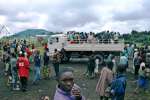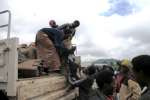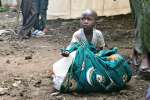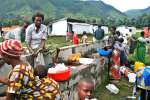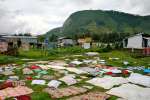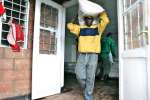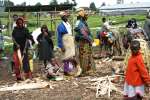Refugees Magazine Issue 110 (Crisis in the Great Lakes) - Rwanda: Going home ... to an uncertain future
Refugees Magazine, 1 December 1997
When refugees began returning in large numbers to Rwanda, the repatriation was almost as chaotic and traumatic as the original exodus
By Paul Stromberg
When logistician Geoff Wordley called UNHCR headquarters in Geneva and asked for a fleet of 400 trucks to mount a massive humanitarian operation in eastern Zaire virtually overnight in late 1996, the response was one of incredulity. 'They called back saying 'We'll give you half.''' Wordley said. 'They thought I'd lost my senses.'
Organizations such as UNHCR had anticipated this moment for more than two years, carefully preparing contingency plans for the peaceful, and hopefully orderly and coordinated return of more than two million Rwandans who had fled the country in 1994. In the event, the repatriation was almost as chaotic and traumatic as the original exodus.
As rebels swept through eastern Zaire, toppling a string of camps, Hutu refugees began to trickle and then flood back into Rwanda. In less than a week in November, 1996, more than a half million people surged back towards the homes they had abandoned in so much hate and haste two years earlier. Humanitarian and government officials at first tried to control the flow, but were quickly swept along with it. Wordley eventually got his trucks, but longtime repatriation blueprints were rewritten or simply ripped up and thrown out. 'It was like trying to load the ark two-by-two, but the waters had already reached shoulder level,' one overwhelmed aid official said.
The Rwanda government closed down transit centres and dispensaries which threatened to interrupt the inexorable refugee movement. Food and return packages were distributed on an ad hoc basis. Field workers trying to reinforce overworked frontline offices were forced back by the crowds.
RETURN TO A STRICKEN LAND
One month later, hundreds of thousands of refugees began to swarm into Rwanda from the opposite direction, from Tanzania. Hardline Hutu leaders had once again tried to thwart any voluntary repatriation by leading refugees pied-piper-style from the camps into the surrounding hills, but in a no-nonsense operation Tanzanian troops eventually forced the civilians across the border.
There were some deaths among the Rwandans streaming home, but given the huge numbers of people involved and the traumatic events they had already lived through, casualties were remarkably low.
The refugees returned to a country still stricken physically and psychologically by the genocide. A new government was installed in Kigali amid promises to heal the ethnic wounds between the Hutu and Tutsi communities. The international community offered lavish aid. A host of humanitarian and other organizations pledged their support. Most of the outsiders, however, vastly underrated the enormity of the task of piecing Rwanda together again after such a catastrophe.
That became clear within weeks when three Spanish medical workers were cold-bloodedly murdered in their homes in the north-west town of Ruhengeri – the first of a series of killings of international aid workers. The UN declared much of western Rwanda off-limits and aid and human rights monitors returned to Kigali.
AN UPHILL TASK
The pullback meant that the monitoring of individual returnees – the most important part of UNHCR's work in Rwanda – was effectively halted in many of the country's Prefectures early in 1997. Field workers agonized over their dilemma: the evacuations from Zaire were undertaken as essential life-saving evacuations, but once they were back home, UNHCR was no longer able to monitor the well-being of the returnees in a rapidly deteriorating security situation. Attempts to carry out protection visits escorted by government troops proved less than ideal, the soldiers presence unnerving returnees and field workers. The situation improved toward the end of last year when protection officers were again able to visit three-quarters of communes countrywide
In all, UNHCR undertook 55 separate projects, aided by 27 partner agencies in 1997 – all designed to rebuild shattered national institutions and help to smooth the reintegration of the returning refugees.
In some areas, that was proving extremely difficult, if not downright hazardous. The number of summary arrests and detentions jumped sharply from around 75,000 in October, 1996 to 120,000 late last year, including an unknown number of returnees. The sheer number of prisoners overwhelmed what remained of the justice system and several agencies, including UNHCR, financed the training of new investigators and judges to try to rebuild the judicial infrastructure.
UNHCR allocated millions of dollars to refurbish and build new schools in an effort to create enough places for all children and avoid a socially explosive pick-and-choose situation.
It also earmarked more than $42 million, half of its 1997 reintegration budget, to shelter projects. By late last year, field personnel had distributed more than 48,000 of a planned 120,000 build-your-own-home kits comprising roofing materials, beams, doors, windows, nails and hardware, particularly in areas which had suffered heavy material damage during the war.
Despite the goodwill of all sides, relations between government and donors were often prickly. Kigali complained that the refugees and the killers in the Tanzanian and Zaire camps had been treated better than the victims left in Rwanda. They disputed figures that as much as $2.5 billion had been pumped into the country since 1994 and refused some projects, including a $38 million programme by the International Monetary Fund to demobilize soldiers.
There was international disquiet about the overcrowded prisons and the establishment of so-called 'solidarity camps' where returning adults and children underwent 'reeducation' before being eligible to attend school or apply for government jobs.
THE KILLINGS BEGIN AGAIN
Whatever progress was made in patching together Rwanda's infrastructure, the question of security appeared likely to determine the country's immediate future. In the past few months, the number of 'security incidents' between government troops and Hutu guerrilla bands increased significantly, turning parts of the country into virtual free-fire zones and causing widespread casualties, mainly among civilians. Late last year in one of the most brutal incidents, attackers murdered nearly 300 Tutsis in a refugee camp in north-western Rwanda, a massacre one official US investigator called a virtual return to genocide. Thousands of people reportedly had already been killed throughout the country.
On a visit to Rwanda at the time, US Secretary of State Madeleine Albright stressed the 'importance of providing security without harm to non-combatants' a reference to civilians caught up in the escalating conflict between the mainly Tutsi army and Hutu rebels. Reflecting the major dilemma facing Rwanda, Albright added: 'I think there is clearly room for improvement in the human rights record of Rwanda. But I think it's also important for us to understand how difficult it is for a country that has seen a half million people slaughtered to put itself back together and reconcile.
'They have done a lot already, but they have a long way to go.'
Source: Refugees Magazine issue 110 (1997)

















































